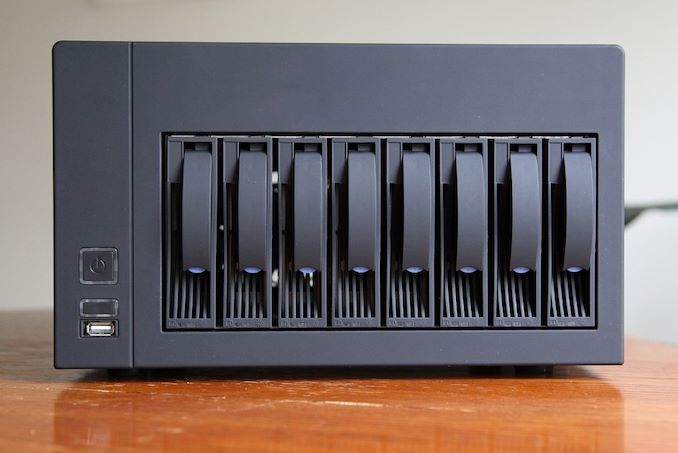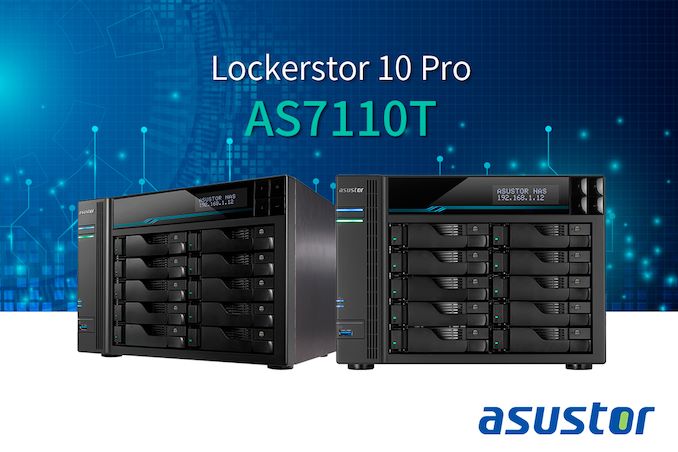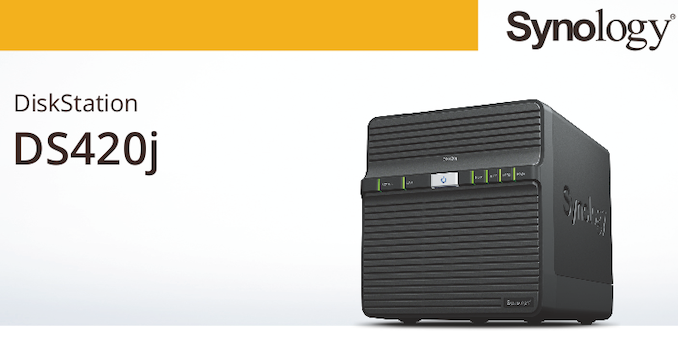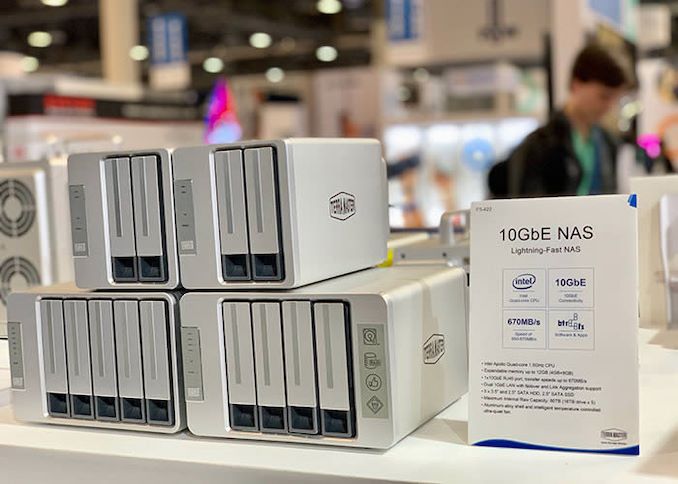Asustor, QNAP, and Synology Introduce New NAS Units at CES 2020
by Ganesh T S on January 10, 2020 6:00 PM EST- Posted in
- Storage
- NAS
- Synology
- QNAP
- Trade Shows
- Asustor
- TerraMaster
- CES 2020

The network-attached storage (NAS) vendors had a relatively quiet presence at CES 2020 compared to what we used to see in earlier years. We have a few announcements and show presence coverage from a couple of vendors to cover, but, a commentary on the current stage of the NAS market is first required to set the stage.
Where is the Network-Attached Storage Market Headed?
As an active follower of the network-attached storage (NAS) market and a media analyst covering CES for more than a decade, the change in the approach of the NAS vendors to the show over time has been interesting to observe. At a higher level, it also shows the direction in which the NAS market is headed. In the early 2010s, the cloud concept was still in its infancy and over-the-top (OTT) streaming was just taking off. However, the rise of smartphones and the associated user-generated content meant that consumers suddenly had a significant amount of data at home that needed access in a centralized manner. A number of vendors attempted to capitalize on this home consumer demand by releasing NAS units catering specifically to this market segment. Fast forward to 2020, and a number of things have changed on the home consumer front:
- Smartphones are backed up by virtually free and virtually unlimited cloud storage, and most consumers are not bothered by the downscaling of the photo and video resolutions
- Cloud-based services also enable easier sharing of content with contacts around the world - an aspect that has been a pain point when the content resides on a local NAS device.
- Cloud-based services such as OneDrive even provide ransomware protection - meaning that even PC / notebook backups for many consumers are moving to the cloud
- Physical media usage has dropped down considerably, and most consumers do not bother to back up their Blu-rays and DVDs. OTT services such as Netflix, Amazon Prime, Disney+, and Hulu are able to provide instant gratification with a good UI and steady stream of new content compared to media stored in a local server.
The factors mentioned above have led to the market for consumer-focused NAS devices experiencing little to no growth in the past couple of years. While the underlying data storage explosion thesis remains unchanged. However, the place where the data gets stored as well as the type of customers who want fast, reliable, and centralized storage with a focus on privacy have become skewed. From the perspective of NAS vendors, the primary growth area is in small businesses and enterprises. We will be seeing hardware and software features focusing on various segments of that market moving forward. For example, QNAP already has Thunderbolt 3-equipped NAS units for enterprises involved in media production.
Where does that leave the consumer NAS models? Since the area is not a growing segment, we will see second tier vendors such as ZyXEL (which last released new NAS units back in 2015) completely exit the market. We also believe that Netgear is completely dropping the home-consumer oriented models in the ReadyNAS lineup. Some vendors (such as Iomega / LenovoEMC) have lso completely exited the NAS market despite having had SMB- and enterprise-focused units in their lineup. Moving forward, the retail crowd will be served by units such as the Western Digital My Cloud Home / Home Duo / Expert / Pro series. Given the huge hard drive capacities, the retail crowd hardly needs more than four bays. This segment is also least bothered by aspects such as SSD caching. Synology, QNAP, and Asustor will release updated models of their 2-bay and 4-bay NAS units every year or two, but the main focus will be on their SMB offerings. On the software side, we believe that NAS apps such as Plex, Twonky Media Server etc. will slowly turn into abandonware. Prosumers and enthusiasts among the home consumers will end up purchasing low- and mid-range SMB NAS units for their privacy-focused centralized data storage needs.
The effects of the above trends has already been seen at CES over the last few years. In the early 2010s, Synology used to have a presence at one of the press events (Pepcom or ShowStoppers) and also a booth in the main show floor. QNAP used to have either a booth or a suite at one of the hotels. Asustor used to share a suite with Asus. At CES 2020, Synology had a fly-in and fly-out presence at Pepcom along with a 4-bay NAS announcement. QNAP did have a booth and a number of announcements, but the focus was mostly on business features. Asustor announced a new business NAS unit, but didn't have any presence at the show. Netgear didn't have any ReadyNAS units on display in their suite. We did have some upcoming / second-tier vendors such as Terramster displaying their wares at the show. Vendors such as QNAP, Synology, and Asustor have begun organizing their own annual user conferences to announce new products and software features. Additionally, other business conferences focused on virtualization, security etc. are turning out to be better events for these NAS vendors. Overall, CES is no longer an important show for the NAS market. Having said that, the rest of this piece captures some of the demonstrations and announcements made in the NAS space as part of CES 2020.
Asustor's Lockerstor 10 Pro
In H2 2019, Asustor had launched the Lockerstor 8 (AS6508T) and Locketstor 10 (AS6510T) tower form-factor NAS units along with demonstrations of the AS-T10G and AS-U2.5G 10Gb and 2.5Gb network adapters. They had also demonstrated updates to various native apps in the Asustor Data Manager (ADM) OS. These Denverton (Atom C3538) units came with dual Intel-based 10GBASE-T ports and dual Realtek-based 2.5G RJ-45 ports along with two M.2 NVMe SSD slots for caching purposes. Priced at $999 (AS6508T) and $1149 (AS6510T), they are cost-effective solutions for SMBs.
The Lockerstor 10 Pro (AS7110T) uses an Intel Xeon quad-core processor with DDR4 ECC memory. This 10-bay NAS comes with a 10Gb port as well as three 2.5Gb ports, has dual M.2 NVMe / SHCI SSD slots, and two USB 3.2 Gen 2 (10 Gbps) ports. Availability is slated for Q1 2020. We do not have any additional details as yet, but, it seems strange that the Lockerstor 8 and 10 come with dual 10Gb ports, while the Lockerstor 10 Pro has got to make do with just one. We have reached out to Asustor for further comments.
QNAP's TS-251D and TS-230
QNAP has been regularly releasing updates to their QTS and also announcing new hardware models throughout the year. As part of CES 2020, they announced the TS-251D (2-bay single-gigabit NAS featuring the Intel Celeron J4005, with a PCIe 2.0 x4 expansion slot for either additional M.2 SSDs or NBASE-T ports up to 10 Gb or USB 3.1 Gen 2 ports) and the TS-230 (2-bay single-gigabit NAS featuring a Realtek RTD1296 quad-core Cortex A53-based SoC and 2GB of DDR4 RAM) for home consumers.
QNAP also launched the VS-8348 VioStor NVR NAS with a Core i5-8400T and QVR Pro native app for SMB video surveillance recording needs. The company has also been focusing on AI solutions. As part of this, they are adding face recognition to their QVR Pro motion search functionality. The same technology is being demonstrated with the QVR Face to monitor staff attendance in office environments, and digital signage products. Another AI application is their KoiMeeter video conferencing solution that can provide audio transcription and real-time translation in meetings. The QuWAN QoS features helps optimize network bandwidth for unhindered meetings. The company has also been making a big push in the network infrastructure space with their Guardian switches. The QGD-1602P was the new product being demonstrated in this segment. An update to the existing QGD-1600P, it integrates 10G SFP+ ports and has a 370W total PoE budget. It can also run the QTS operating system. The QuCPE Edge Computing Server was also being displayed at CES 2020.
Synology's DS420j
Synology announced the 4-bay DS420j NAS at CES 2020, though the details of the unit have been public for a few months now. It is based on the same Realtek RTD1296 used by QNAP in its TS-230 unit. The DS420j accommodates two extra bays compared to that unit and comes with 1GB of RAM . There is a single gigabit LAN port and two USB 3.0 ports in the unit. The unit supports the ext4 filesystem only for the internal volume.
Synology is also promising new features in their updates to the Synology DSM over the course of 2020, but was silent on the details. We look forward to hearing about the new features shortly. On the business / enterprise side, Synology also announced the availability of the SA3600, a 12-bay Xeon-D 1567-based NAS with SATA / SAS support, two 10GB BASE-T ports, and four gigabit LAN ports. The 2U rackmount NAS also comes with two PCIe 3.0 x8 slots and can support both btrfs and ext4 for the internal volume. They key feature of the SA3600 is the expandability offered with the help of the 12- and 24-bay RX1217sas and RX2417sas expansion units. The maximum number of supported drive bays is 180.
Terramaster at CES 2020
Terramaster started off as a direct-attached storage (DAS) manufacturer. We had reviewed one of their offerings back in 2017. Recently, they have started a push on the NAS front too, with products targeting a wide range of customers ranging from home consumers to enterprises. The products on display at CES 2020 were actually the ones launched last year, but they did provide insight into the breadt of their offerings.
The key product from Terramaster, in our opinion, is the surprisingly affordable F5-422. At $570 for a 10GBASE-T Apollo Lake x86-based 5-bay unit supporting btrfs, it doesn't break the bank. However, the platform holds back the maximum speeds to around 650 MBps over the 10GBASE-T port. Terramaster's TOS 4.1 operating system is the Linux-based OS for their NAS units and it comes with a 'desktop-like' UI similar to Synology's DSM. The company also had rackmount enterprise NAS units based on Denverton and Core i3 platforms, as well as Thunderbolt 3-equipped DAS units at their booth.














63 Comments
View All Comments
Reflex - Sunday, January 12, 2020 - link
If you are dealing in terabytes and terabytes of data o a regular basis you aren't using SSD's anyway due to cost of storage plus low density. And you really want to be running some form of RAID so you don't lose it all, which again reduces capacity.The systems you want do exist and most of the higher end NAS' products include either 10Gb or a PCIe slot for you to install your own. And enough drive bays with M.2 caching to take advantage of it with SSDs. Not cheap of course, but it's a professional scenario.
p1esk - Sunday, January 12, 2020 - link
@Reflex: I just ordered TBS-453DX together with four WD Blue M.2 2TB SSDs, which in RAID5 will provide 6TB. It will probably be at least a couple of years to fill it up, and by that time I'll upgrade to 4TB drives (or larger). Regarding 10GbE port - it's more of future proofing the system - I plan to buy a beefy video editing desktop PC soon which will have a 10GbE port, and I will probably buy a small 10GbE switch, and 4 SATA SSDs in RAID5 will most likely be able to saturate 10GbE link.Reflex - Monday, January 13, 2020 - link
The key point is 'on a regular basis'. Anything less than a TB of data transfers more than fast enough to a SATA SSD or HDD with a M.2 cache (1TB NVMe drives are cheap). Unless one is routinely syncing multiple TB's with the NAS, which if your total capacity is 6TB and it will take 'years' to fill you aren't, this is overkill. Even in a scenario where you are working actively with terabytes of data on the fly rather than simply working on it locally and then syncing or uploading to the NAS, you are better off with a TB enclosure than an ethernet NAS.My NAS currently has 32TB, I sync a ton of media to it and with a 1TB M.2 it's plenty fast enough, after all there are multiple limiters involved that aren't the network link both on the host and the clients.
I'm glad that you were able to buy the specifications you liked, however. My guess is in a couple years you realize you massively overspent for future proofing when you'd have been better off buying what you needed today and upgrading when your real world use cases justified it.
ABR - Saturday, January 11, 2020 - link
Problem is most of their lineups are in the stone age with 3.5" bays, big fans, and bulky form factors. The product TomaBgd pointed out is a rare bird, and they do charge for that rarity.tokyojerry - Saturday, January 11, 2020 - link
Except that QNAP designed it with USB-A ports versus USB-C ports which doesn't make much sense for a device that is an M.2 NVMe SSD-based NASlilkwarrior - Saturday, January 11, 2020 - link
Yeah, that didn't make any sense. USB4 USB-C / Thunderbolt 3 should be the only USB anything 2020 NAS should have.imaheadcase - Saturday, January 11, 2020 - link
I would argue that a NAS doesn't need any of those. Most people have them out of hands reach anyways, pretty much dumb devices. Its why they have remote UI.Reflex - Sunday, January 12, 2020 - link
Yes, a NAS is rarely directly interacted with, and most of the devices that get plugged into the USB ports are things like a UPS for power stability, a printer for the print server and sometimes a WiFi dongle. These are not devices that need more than USB3.tokyojerry - Saturday, January 11, 2020 - link
... unless you use it locally as DAS with USB-C quick access. (Ref TS-653B)schujj07 - Saturday, January 11, 2020 - link
If you want a NAS with SSD storage, you will want more than 10GbE. Minimum I would want would be dual 25GbE ports to be able to take advantage of the SSD. Reason for that is a 10 disk RAID50 array of 3.5" disks can flood a 10GbE link with ease on sequential writes.